CURRENT AFFAIRS – 05/05/2023
Summer boost
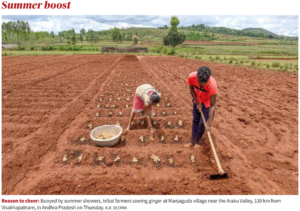
Reason to cheer: Buoyed by summer showers, tribal farmers sowing ginger at Manjaguda village near the Araku Valley, 130 km from Visakhapatnam, in Andhra Pradesh on Thursday. K.R. Deepak
Many killed in riots in Manipur; govt. issues
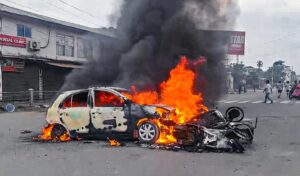
shoot-at-sight order
Vehicles set afire in the State capital Imphal on Thursday. PTI
Clashes broke out after a march was taken out by tribes against decision to grant ST status to the majority Meitei community; Army and RAF deployed
RAHUL KARMAKAR
GUWAHATI
The Manipur government on Thursday issued a shoot-at-sight order in “extreme cases”, as escalating ethnic violence following a tribal solidarity march displaced over 9,000 people in the State.
There was no official confirmation of the number of people killed or injured in the violence, but Chief Minister Nongthombam Biren Singh admitted that “some precious lives were lost”.
Clashes initially broke out during the course of Wednesday’s solidarity march, called by the All Tribal Students’ Union, Manipur. The Scheduled Tribe communities, mostly from the Kuki-Zomi group, are protesting against a move to grant a long-standing demand for ST status to the Meitei community, which makes up the majority of the State’s population.
Shoot-at-sight order issued in Manipur
On April 19, the Manipur High Court directed the State government to submit its recommendation to include the Meiteis in the ST list to the Union Tribal Affairs Ministry by May 29.
Mr. Biren Singh appealed to the people to maintain peace and harmony, soon after updating Home Minister Amit Shah about the situation.
Hundreds of houses, churches, temples, and vehicles were either vandalised or set ablaze across five districts: Imphal, Churachandpur, Bishnupur, Kangpokpi, and Tengnoupal. Among the seriously injured was Manipur MLA and former Tribal Affairs Minister, Vungzagin Valte, who was admitted to hospital after a mob attacked his official residence in the State capital Imphal.
Curfew continued in some districts, while Internet services were suspended. Nearly 500 personnel of the Rapid Action Force were flown in on Thursday morning. They joined 55 columns of the Army and the paramilitary Assam Rifles, apart from the police.
Officials said the Imphal-Churachandpur road, the axis along which much of the violence took place, had been secured by the combined forces.
“The Army and Assam Rifles personnel are conducting flag marches and aerial reconnaissance in the affected areas. We have rescued 5,000 people in Churachandpur and 2,000 each in Imphal and Moreh and lodged them in safe places,” a defence spokesperson said. An additional 14 columns of the Army and paramilitary force have been kept on standby for deployment on short notice, he added.
The heightened security did not deter mobs from attacking vulnerable spots. Assessing the situation, Governor Anusuiya Uikey authorised all district magistrates and executive magistrates to issue shoot-at-sight orders “in extreme cases whereby all forms of persuasion, warning, reasonable force etc has been exhausted”.
The order came hours after Mr. Shah called up Mr. Singh and took stock of the situation. The Union Home Ministry appointed Kuldiep Singh, former Director-General of the CRPF, as the CM’s security adviser. Mr. Shah chaired two video conferences with Mr. Singh, the State police chief and other senior officials and also conferred with the CMs of Nagaland, Mizoram and Assam.
(With inputs from Vijaita Singh in New Delhi)
Families flee homes, take shelter in relief camps after violence in Manipur
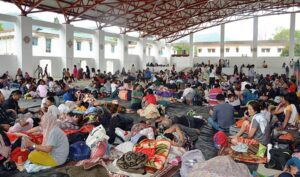
Brief respite: People from violence-affected areas take rest at a shelter arranged by the Army on Thursday. ANI
ABHINAY LAKSHMAN
NEW DELHI
Many families in Manipur’s capital Imphal and nearby districts have been forced to take refuge in shelter camps, after mounting violence in the State over the issue of Scheduled Tribe status for the Meitei community.
Golan Naulak, 36, said he fled his home in eastern Imphal with four family members on Thursday. “It is a complete failure of the state machinery. Mobs are roaming around freely. We have lost our home, my car, documents and all our belongings. We are currently taking shelter at the compound of Manipur Rifles in the city,” he told The Hindu over phone.
Clashes between the Scheduled Tribe communities opposing ST status for the Meitei people and those belonging to the Meitei community have left panic and confusion in their wake. Some families, whose homes were set on fire, escaped to neighbours’ homes or found refuge in the compound of Manipur University. Others moved to the relief camps that were set up in the city.
Several residents who spoke to The Hindu over the phone said there were attacks by mobs comprising Meitei people.
While it was announced by the government that mobile Internet would not be available in a few districts as a precaution, broadband facilities were also disrupted in some places. “Around 2 p.m. on Thursday, we lost our home Wi-Fi. In about an hour, a mob of around 300 people stormed our neighbourhood and started vandalising homes,” Mr. Naulak said.
A 25-year-old schoolteacher, who belongs to a Scheduled Tribe, said, “We have been told that more than a dozen churches have been vandalised in and around Imphal. We also saw a hospital run by the Kuki Christian Church being burnt down.”
When she spoke on the phone, she was trying to make it to a relief camp with 11 other family members, including two infants, a disabled aunt and elderly grandparents.
Even as Adivasi residents in and around Imphal and Churachandpur say their homes and villages were being raided by mobs of Meitei people, members of the Meitei Tribe Union have blamed “illegal migrants from Burma” for fuelling the violence.
Manihar Moirangthem Kongpal, adviser to the Meitei Tribe Union, claimed that the entire Meitei community in areas like Churachandpur and Moreh was facing violence at the hands of “such miscreants”. He insisted that the violence was purportedly started by those associated with Kuki associations. There were reports that some Meitei homes had also been attacked and these families too were fleeing to safety.
And another airline bites the dust
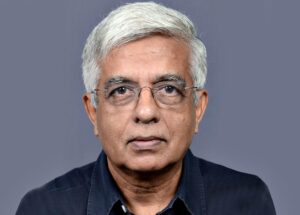
Captain A. (Mohan) Ranganathan
is a former airline instructor pilot and aviation safety adviser. He is also a former member of the Civil Aviation Safety Advisory Council (CASAC), India
The proprietors of Go First declaring insolvency is part of a familiar aviation story in India: of serious deficiencies in the sector.
The line from the famous song by Queen (Farrokh Bulsara), “Another One Bites the Dust”, appears to be the swansong for another airline in India. In the 1990s, an airline with promise, Damania Airways, went bust. This week, the Wadias declared insolvency for their airline, Go First, bringing down the curtains on another airline company. In its wake, we have hundreds of passengers, pilots and cabin crew stranded in various locations, and thousands of employees who have been left in the lurch with a long legal battle ahead of them to salvage what is owed to them. Employees of Kingfisher Airlines and Jet Airways are still struggling to get their dues while their owners and promoters live a life of luxury with zero accountability.
Are airlines and their owners/promoters the only ones to blame for these failures? I would put the blame squarely on the Ministry of Civil Aviation and its puppet, the Directorate General of Civil Aviation (DGCA). The regular chest thumping acts where there are proclamations of India being the ‘fastest growing aviation sector’ also turn a blind eye to serious deficiencies in safety, the financial security of airlines, oversight audits by the DGCA to assess the financial health of airlines, and last but not the least, the inflated numbers game they play to project exponential growth in the aviation sector.
A story of distress
The last 30 years have seen the failure of Damania Airways, NEPC Airlines, Air Deccan, Air Sahara, Paramount, Kingfisher, Jet Airways and several other smaller airlines in the aviation sector in India.
In 2008, the financial world’s collapse resulted in problems for major airlines. The Boeing representative made a statement during the Singapore Airshow in 2009 that India has space for just three airlines and that consolidations and mergers would take place.
Back in India, crony capitalism ensured that the favoured lot were never questioned and banks kept pumping in funds to aid non-performing assets. A DGCA audit of Kingfisher Airlines indicated a clear case of deep financial stress. As in the DGCA’s normal procedure, the reports were consigned to the dustbin. There were similar results for Jet Airways before its collapse too. The airline’s board was loaded with former Ministry of Civil Aviation and DGCA officials, just to give the reader an example of how airlines in India operate and hoodwink the public. The media helped in dishing out the figures and the numbers handed out to them without due diligence or any cross checks being done.
The DGCA’s Civil Aviation Requirement for Scheduled Transport Operations clearly spells out the minimum requirement for starting/running an airline: finance, crew numbers, other staff and route projections. Yet, those setting up airlines announce grandiose plans with the blessings of the Ministry and the DGCA, without proven financial security, and without a minimum number of pilots, engineers and cabin crew. Has anyone checked whether the numbers projected and numbers that actually materialised have matched? Has anyone checked why India pays the highest lease charges for aircraft when compared to other countries? Has the DGCA, the so-called regulator, ever taken action against those who make and come up with false projections and numbers? Pleasing the Minister and pandering to the ego of the government is not going to prevent another airline going bust.
After the worst of the COVID-19 pandemic was over, it was obvious that every airline in India was deep in the red. Areas that take a hit for airlines in India include training and safety. Airlines know that as long as their umbilical cord is connected to the Ministry of Civil Aviation, the regulator is a mere facilitator. Has the DGCA done a financial audit of all the airlines in India and has it published its findings?
Warning signals
The number of aircraft that have been mothballed in several airports in India and the number of accidents and serious incidents over the months have not raised a red flag. Passengers have been lucky that more lives have not been lost. This false numbness is likely to be mushrooming shortly.
Leasing companies repossessing aircraft due to non-payment of lease charges and airports requiring cash and carry operations from an airline for airport and fuel charges are all clear indications that the financial health of the airline is in a state of deterioration. Another clear pointer is the cancellation of flights due to “operational reasons”.
In simple terms, it means that there is a shortage of crew. Will the DGCA publish the data on flight cancellations because of crew shortage? Will it take the bold step of preventing airlines from acquiring more aircraft until they can show that they have sufficient numbers of crew for continuous scheduled operations without any flight disruptions?
Revamp aviation policy
What is urgently required in Indian aviation is transparency and accountability. This includes not just the airline owners and promoters but also the Ministry of Civil Aviation, the DGCA and the officials concerned. The day is not far off when another favoured and propped up airline is going to lose its wings. Go First is just the new beginning. And it is not going to be the last. A complete revamp of India’s civil aviation policy is required. We have seen the charade of Jet Airways 2.0, where some people have skimmed from the top and pulled wool over the eyes of unfortunate employees waiting for their legitimate dues. To begin with, they should enforce a ban on any official of a failed airline from holding managerial posts in another airline. Airlines should also be asked to have a corpus fund locked up to meet the dues of employees and passengers in the event of an airline closing down. The sudden announcement by Go First of operations being put on hold is like the announcement of demonetisation, in 2016. Do people deserve this disservice?
India is a goldmine for tourism. Aviation is a sector that is important to cash in on this. But the way it has been mismanaged and killed makes one wonder whether we can ever reach the potential to become the fastest growing sector. We need professionals with knowledge to run the sector. The way Air India is heading, I worry for another venture. My empathies for J.R.D. Tata. The vision he had for aviation in India is crumbling rapidly.
Do CCTV cameras protect us or invade our privacy?
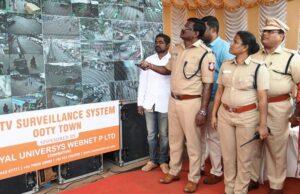
Niligiris District Superintendent of Police K. Prabhakar inaugurating the CCTV camera surveillance in Udhagamandalam. Sathyamoorthy M.
There is no law which regulates how the data is collected, processed, stored, when it should be deleted, or with whom it can be shared.
PARLEY
India’s CCTV camera coverage has grown rapidly over the years. Today, Delhi and Chennai have more cameras per square mile than cities in China. States argue that CCTV cameras reduce crime, and the public finds the presence of these cameras reassuring. In a survey conducted by Lokniti-Centre for the Study of Developing Societies in August 2022 in 12 States, more than three-fourths of the respondents supported installing CCTV cameras at the entrance of their homes. However, surveillance is a big concern. Recently, in Telangana, the wrong man was apprehended when authorities purportedly recognised him from security camera footage as a potential culprit in a chain-snatching event. He died days after being released. In a conversation moderated by Sonikka Loganathan, Srinivas Kodali and Anushka Jain discuss whether CCTVs are helping the police fight crime or are being used as a tool to invade privacy. Edited excerpts:
Do more CCTV cameras help reduce crime?
Srinivas Kodali: This is a claim. We don’t have any evidence. But it’s clear that the cameras don’t always function.
Anushka Jain: The state says this because they want to be seen as doing something to reduce crime. There are multiple studies in the U.K. which show that there is no connection between CCTV cameras and reduction of crime. If the claim is that cameras will increase women’s safety, then why are crimes against women not going down? The majority of crimes against women take place at home. CCTV cameras are not helpful in those situations. And, like Srinivas said, most CCTV cameras don’t even work.
A CAG audit of 2018-19 stated that only 55-68% cameras were working in Delhi. Do you think that cameras still help the police identify suspects?
SK: They help the police close cases by figuring out who the criminal is, but they don’t always work. If a crime scene has no CCTV footage, that case rarely gets solved. And there is an over-reliance on these systems, which leads to false negatives and false positives.
AJ: A false negative means that the police have not been able to identify the criminal and he goes free. A false positive means that an innocent person is identified as the suspect.
Do you think that the pros of CCTV/facial recognition outweigh privacy concerns?
SK: It’s not just about facial recognition; the police use CCTV cameras to identify cars and bikes which are speeding or have been used in a robbery. In theory, this is great. The challenge is that we don’t know what the police are using the footage for otherwise. Are they using it at protest sites? Even if there is no CCTV camera at the site, the police use their phones or handy cameras for recording because they are afraid that something untoward might happen. There could be somebody at the protest who was politically motivated to cause harm, which is true, and the police should be allowed to do this. But there has to be an oversight of the actions of the police thereafter, which does not happen. And that’s the real challenge — when you don’t know what they’re going to do with this data. So, it’s not just about policing the bad people; good people may also get harmed.
AJ: They have a database against which they match the CCTV footage. The database could be the criminal tracking network system, passport, or licence records. That is how facial recognition works. It depends on how long the database is supposed to have your data. According to the Criminal Procedure (Identification) Act, fingerprints, handprints or any evidence can be kept for 75 years. Why 75 years? There is no explanation. So, even after you die, evidence such as your fingerprints could be on record. What is the point of that? Like Srinivas said, the task of the police is to not just investigate crimes, but maintain public order. There are barriers to how freely people can protest and one of them is police intimidation. For example, if the police record me while I am protesting, this can affect not just me, but have a chilling effect on others. They may be scared to be identified by the police. The right to protest, to freedom of speech and to privacy all get violated. Just because I’m in a public space does not mean that my right to privacy has ended.
How is surveillance integrated into the legal framework?
AJ: There is no law which regulates how the data is collected, processed, stored, when it should be deleted, or with whom it can be shared. There is no specific law with regard to facial recognition, or a standard operating procedure on how the police should use CCTVs or facial recognition technology.
SK: The Criminal Procedure (Identification) Act allows police departments to use new technologies — not just facial recognition but also fingerprint recognition, voice detection, etc. And there is no oversight. For instance, the New York and London police departments have oversight committees. When there is a violation of civil rights, you can file a complaint against the police. India does not have that. Also, if I don’t know what evidence is being collected and how these systems function, how do I challenge them in courts? Even judges are not always familiar with these systems. The State police departments have police manuals and standing orders. Ideally, the use of facial recognition and all evidentiary practices need to be part of these manuals. But you won’t find it in, say, the Telangana police manual.
If I want my footage of walking down a street wiped from a police camera because I just don’t want it there, there is nothing I can do?
SK: Technically, you can file an RTI and request footage. But they always say that they don’t store the footage for more than 30 days. When you file an RTI, they have to reply within 30 days. So their reply will be that it has been deleted.
It is easy to tamper with video footage these days. Is camera footage reliable evidence?
AK: To use CCTV evidence, there are conditions laid out under the Indian Evidence Act (Section 65B). There is a certificate that has to be obtained. But often the hardware is damaged and the quality of the recording is poor. So, even if you know that the recording has been made legally, it could still not be sufficient evidence. And yes technology has transformed so much that it’s difficult to identify tampering of footage.
SK: If there is any footage, no matter how it was obtained, courts may take the side of the police. But it should be the police who have to prove that this is authentic. If you have CCTV footage of a man at a place, but his phone was somewhere else, he can make the argument that he wasn’t at that spot. But obtaining call records is hard for an individual. The police can obtain them easily. So, people who are being accused of something do not have the power to question the accusation.
Do you think that lack of laws is indirectly promoting misuse?
AJ: I don’t want to attribute malice. I feel that, when somebody is working for a cause, they become convinced (that what they are doing is right). Sometimes they rely more on CCTV when they should not, or they don’t show evidence that may not support their theory. They justify those actions saying they are doing all this to remove criminals from the street. Maybe they do this because they are convinced that the person has committed the crime and they are not able to prove it. However, there needs to be a human rights assessment of these technologies, how they are being used by the police. When they are used correctly, what are the benefits and are they comparable to the harm being caused?
Can the government access CCTV footage?
AJ: This brings us back to the need to adopt data protection principles like purpose limitation and storage limitation. This means that only the data to be used for a lawful purpose is collected. It is stored only for the time until which the purpose is carried out. After that it is deleted. There is a legal vacuum when it comes to these systems and processes. So, the data that you’ve shared with the government could hypothetically be accessed by the police and vice-versa.
Why is there a legal vacuum even years after CCTVs were introduced to the public?
SK: A lot of these systems came into place because of society’s demands. CCTVs primarily were pushed from a woman safety angle. The idea was to invest in them because of the failures that took place during the Mumbai attacks too. We were modernising our entire policing infrastructure, so we began experimenting with technologies. If you look at how governance functions, you do a pilot project. If it succeeds, you expand it. There were multiple pilots conducted. If Hyderabad invested in facial recognition, Andhra Pradesh invested in iris recognition. There are different police departments and because the police are under the control of the State governments, States decide what they want to do. Laws are brought about to protect citizens, but in this case national security is being used as an excuse not to bring laws to control state surveillance.
Ex-Proud Boys leader Tarrio guilty of Jan. 6 sedition plot
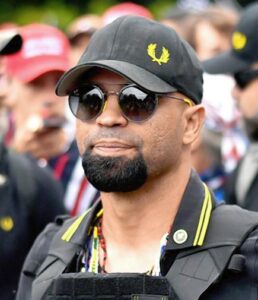
Enrique Tarrio
ASSOCIATED PRESS
WASHINGTON
Former Proud Boys leader Enrique Tarrio was convicted on Thursday of orchestrating a plot for members of his far-right extremist group to attack the U.S. Capitol in a desperate bid to keep Donald Trump in power after the Republican lost the 2020 presidential election.
A jury in Washington, D.C., found Tarrio guilty of seditious conspiracy after hearing from dozens of witnesses over more than three months in one of the most serious cases brought in the stunning attack that unfolded on January 6, 2021, as the world watched on live TV.
It’s a significant milestone for the Justice Department, which has now secured seditious conspiracy convictions against the leaders of two major extremist groups prosecutors say were intent on keeping Democrat Joe Biden out of the White House at all costs.
The charge carries a prison sentence of up to 20 years.
Tarrio was a top target of what has become the largest Justice Department investigation in American history. He led the neo-fascist group — known for street fights with left-wing activists — when Mr. Trump infamously told the Proud Boys to “stand back and stand by” during his first debate with Mr. Biden.
Brain behind attack
Tarrio wasn’t in Washington on January 6, because he had been arrested two days earlier in a separate case and ordered out of the capital city. But prosecutors said he organised and directed the attack by Proud Boys who stormed the Capitol that day.
Prosecutors told jurors the group viewed itself as “Trump’s Army” and was prepared for “all-out war” to stop Mr. Biden from becoming President.
Defence lawyers denied there was any plot to attack the Capitol or stop Congress’ certification of Mr. Biden’s win. A lawyer for Tarrio sought to push the blame onto Mr. Trump, arguing the former President incited the pro-Trump mob’s attack when he urged the crowd near the White House to “fight like hell.”
Tarrio, a Miami resident, was charged and tried with four other Proud Boys: Ethan Nordean, Joseph Biggs, Zachary Rehl and Dominic Pezzola.
The Justice Department hadn’t tried a seditious conspiracy case in a decade before a jury convicted another extremist group leader, Oath Keepers founder Stewart Rhodes, of the Civil War-era charge last year.
APSEZ exits Myanmar port in $30-million fire sale
THE HINDU BUREAU
MUMBAI
Adani Ports and Special Economic Zone Ltd. (APSEZ) said it has concluded the sale of its investment in a Myanmar port for $30 million based on an independent valuation.
The sanction-hit Myanmar-based port — Coastal International Terminal Pte. Ltd. — has been sold to U.K.-based Solar Energy Ltd. at a substantial discount. APSEZ had invested about $150 million in the project.
The buyer will pay the amount within three business days once APSEZ meets all compliances.
On the Washington Declaration
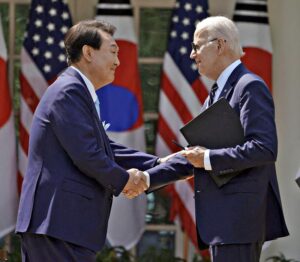
Firm ties: U.S. President Joe Biden and South Korea’s President Yoon Suk Yeol on April 26.REUTERS
What prompted the visit of South Korean President Yoon Suk Yeol to the U.S.? Why does South Korea not have its own nuclear arsenal? What is the significance of the new agreement? How does it relate to nuclear deterrence? How have China and North Korea responded?
FEMY FRANCIS
EXPLAINER
The story so far:
On April 25, South Korean President Yoon Suk Yeol arrived in the U.S. to commemorate the 70th anniversary of U.S.-South Korea bilateral relations. A highlight of the visit was the signing of the “Washington Declaration” as a nuclear deterrence strategy.
What prompted the U.S. visit?
The successful launch of North Korea’s Hwasong-8 solid-fuel intercontinental ballistic missile (ICBM), a vital component for nuclear weapons delivery, seems to have triggered the U.S. visit of the South Korean President. Mr.Yoon aimed to advance the strategic partnership, drawing an alliance over an extended nuclear deterrence plan against the regional aggression of North Korea. The Washington agreement will launch a new phase in the partnership between Seoul and Washington. “Our two countries have agreed to immediate bilateral presidential consultations in the event of North Korea’s nuclear attack and promised to respond swiftly, overwhelmingly and decisively using the full force of the alliance, including the United States’ nuclear weapons,” said Mr.Yoon.
What does the Washington Declaration say?
The agreement outlines cooperation towards deterrence.
According to the declaration, an American nuclear ballistic submarine would be deployed in the Korean peninsula; a nuclear consultative group would be formed to formulate principles of joint response tactics; South Korea would receive Intel from the U.S. regarding nuclear advancements; and the U.S. will strengthen South Korea’s nuclear deterrence capabilities through joint military training programs and an annual intergovernmental simulation. The declaration reaffirmed the non-proliferation Treaty implying that South Korea would not venture into the creation of its own independent nuclear capabilities and would instead focus on deterrence measures through an alliance-based approach. It also mandates the U.S. President as the only ‘sole authority’ to use the nuclear arsenal of the U.S. in the event of a nuclear confrontation. While the existence of the agreement is based on the security needs of South Korea, the policy reflects big power politics where the interests of the larger power (U.S.) takes precedence.
Why is the U.S. not keen on S.Korea having a nuclear arsenal?
South Korea’s nuclear development programme supported by former president Park Chung Hee was hindered due to U.S. pressure. In the 1990s, the U.S. withdrew one hundred nuclear weapons from South Korea as part of their “Strategic Arms Reduction Treaty”. The U.S. was hoping to make North Korea unarm itself. Washington made an erroneous assumption that it could deter the weapons production of North Korea by extracting South Korea’s nuclear capacity.
Secondly, the Nuclear Posture Review 2022 reflects a shift in the U.S. narrative where it is now concerned about the progressing nuclear capacities of North Korea. The report states that North Korea creates “deterrence dilemmas for the United States and its Allies and partners,” and that “a crisis or conflict on the Korean Peninsula could involve a number of nuclear-armed actors, raising the risk of broader conflict.”
And finally, the U.S. wants to control global nuclear arms production. It has been reluctant to allow South Korea to develop their own nuclear arsenal as it would hinder the prolonged efforts of controlling nuclear production in the world. The assurance that the U.S. and its nuclear weapons would protect its allies by being responsible for maintaining stability in the region aligns with the larger goal of non-proliferation. Washington plays a major influence in South Korea’s foreign policy objectives, and Seoul would rather not disappoint the U.S. as they are a vital supporter of their cause.
What has been the regional response?
The Washington Declaration advocates for nuclear deterrence policy in the region, aiming to balance power dynamics against North Korea. While the aim is to defuse the threat, physical deployment of the arsenal can be deemed as a direct threat by opposing actors and used as leverage to act aggressively.
China criticised the agreement with Foreign Ministry spokeswoman Mao Ning saying, “What the U.S. is doing .. provokes confrontation between camps, undermines the nuclear non-proliferation regime and the strategic interests of other countries.” North Korean leader Kim Jong-Un’s sister Kim Yo-jong warned that the declaration would, “only result in making peace and security of North-East Asia and the world be exposed to more serious danger.”
What is the domestic response?
The South Korean public are sceptic about U.S. support. A poll by the Chicago Council on Foreign Relations reported that 71% of South Koreans want to build their own nuclear weapons. With an aggressive North Korea in the neighbourhood, they would prefer their own deterrence.
The writer is a Research Assistant at the National Institute of Advanced Studies (NIAS), Bengaluru
THE GIST
-
On April 25, South Korean President Yoon Suk Yeol arrived in the U.S. to commemorate the 70th anniversary of U.S.-South Korea bilateral relations.
-
Mr.Yoon aimed to advance the strategic partnership, drawing an alliance over an extended nuclear deterrence plan against the regional aggression of North Korea.
-
The declaration reaffirmed the non-proliferation Treaty implying that South Korea would not venture into the creation of its own independent nuclear capabilities.